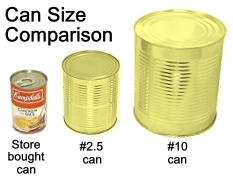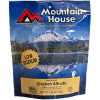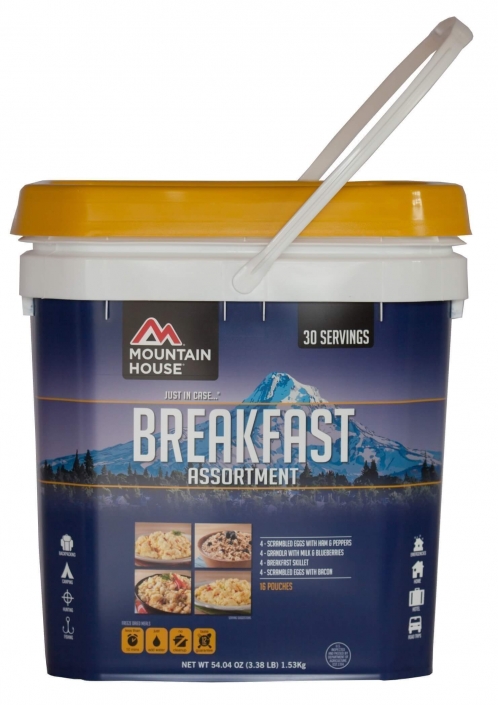Shop Products
+ Expands - Collapse
- Food Kits
- Product Brands
- Products
Packaging Details of Freeze Dried
and Dehydrated Food
We offer a variety of packaging types for our food products. Products packed in pouches, #2.5 cans, #10 cans, and 5 gallon buckets contain an oxygen absorber. See this link on shelf life and storage conditions for the different products available and how you can dramatically increase your food storage shelf life.
For best storage and longest life, either cans or buckets are recommended. Paper bags and "boxed" products are NOT recommended for long term storage unless you repackage these yourself into airtight containers with oxygen absorbers. We also sell buckets and oxygen absorbers so you can do this yourself. Pouch products have a more limited recommended shelf life due to the packaging (pouches are not hard-sided like cans or buckets).
Periodic inspection of your food storage is highly recommended to ensure proper storage conditions.
Container Sizes
 SP = Super Pail: This is a heavy food grade plastic bucket with the added insurance of a metalized nonporous mylar bag. The bag is filled with the product and an 500cc oxygen absorber packet to remove oxygen. The bag is vacuum sealed and the bucket is sealed with a gasketed lid. The mylar bag protects the product from light, moisture and oxygen. Because of the air proof nature of the mylar bag, your product will remain 99.5% oxygen free. All buckets must be inspected periodically to ensure integrity.
SP = Super Pail: This is a heavy food grade plastic bucket with the added insurance of a metalized nonporous mylar bag. The bag is filled with the product and an 500cc oxygen absorber packet to remove oxygen. The bag is vacuum sealed and the bucket is sealed with a gasketed lid. The mylar bag protects the product from light, moisture and oxygen. Because of the air proof nature of the mylar bag, your product will remain 99.5% oxygen free. All buckets must be inspected periodically to ensure integrity.
5 gallon buckets are - 15" tall, 11 3/4" in diameter.
6 gallon buckets are 17.5" tall, 12" in diameter. 6 gallon buckets have been discontinued effective July 1st, 2019
RB = Ribbed Bucket: This is the same bucket as the Super Pail, but without the insurance of the mylar bag. Ribbed Buckets have since been discontinued in favor of the storage benefits Super Pails provide. In the event that the bucket is punctured or damaged, there is no 'second skin' to protect your food. All buckets must be inspected periodically to ensure integrity.
Buckets are "made to order", ensuring the freshest possible pack date. No date codes are used on buckets, the ship date should be used as their packaging date.
Important notes on buckets:
- Buckets may be dented upon arrival. This is the affect of barometric pressure differential and is a "good sign", since it indicates a tight seal on the gasket lid. Not all buckets will dent, head gasses vary depending on product. If these are SP buckets (the food is in a sealed mylar bag inside) and you want to remove the dents, you can crack the lid open and allow in some air, but this is not necessary or generally recommended. Dents can be ignored unless they are problematic and threaten the integrity of the bucket. In the case of severe dents the lids can be removed on SP buckets (products with mylar bags) and the sides pushed out and the lid replaced. Do not do this on RB (ribbed) buckets as they do not have a mylar bag inside. We always recommend the SP buckets over the RB buckets since the mylar bag provides an extra layer of protection.
- Products containing leaven (yeast) such as Biscuit Mix can expand due to activated leaven. If this happens, carbon dioxide gas is created (CO2), expanding the container. C02 is harmless and is actually used to preserve food in the "dry ice" method (adding dry ice to a bucket), a common food-storage technique. Excess CO2 can simply be bled off (make a tiny hole in the top of the bag) and the mylar bag resealed (tape works, or use a hot iron on a mylar bag). Products containing leaven have a shorter shelf life, see our shelf life page for further information.

Can products - There are two types of cans we use for freeze dried and dehydrated food. The size 10 can is the large coffee can size everyone is familiar with (1 gallon). The size 2.5 can is the smaller can, the size of a large soup can.
Each can has one oxygen absorber packet which insures that contents remain 99.5% oxygen free. Size 10 cans use a 500cc absorber and size 2.5 cans use a 300cc absorber.
(6) size 10 cans is a full case (box), boxes are 13" x 19" x 7.5".
All cans are shipped dent free from the cannery. We do not ship out dented cans. Any can that is received severely dented on the seam or fold of the can is considered damaged and is caused during shipment mishandling. Any minor dent elsewhere on the can is not considered damaged because the food is dehydrated and has different guidelines than other canned foods such as wet-pack foods found in the supermarket.

Pouch Products are available from Rainy Day and Mountain House. Rainy Day also offers some 5 lb mylar bags that are "pouches". They all use a heavy foil / mylar pouch with or without ziplock openings, and are all date coded. 2 person and 4 person sizes are most common, there are larger sizes too depending upon the product (read the descriptions to determine sizes). We have found that pouch products can usually be eaten well beyond their expiration dates by several years.
Mountain House pouch products come in a cardboard box, dimensions 9.5" wide x 8.75" tall x 8.5" deep. These products can be prepared right inside the pouch (just add hot water).

Square Buckets
These type of square buckets are not airtight (no square lid bucket is airtight from any manufacturer), but the pouches inside are airtight. These are designed to store sealed food pouches in a durable hard sided container that has the added benefits of being portable, stackable, and keeping the pouches dry and protected.
Rainy Day uses the 5 gallon Ribbed Bucket (RB) bucket (which is round and airtight) for their Quick & Easy Entree kit which contains sealed mylar pouches.
Mountain House square bucket dimensions: 10” x 9.25” x 13”.
Information on Date Codes
Rainy Day: All of our cans are date coded. Rainy Day use Julian date codes on their cans. This is an ink stamp on the top of the can.
Example: 10303 Cabbage 32809. The first set of numbers is the product code. The second set of number is the Julian date (packing date). This can was packed 328th day of 2009.
Buckets - see bucket pack date comments above, buckets are "made to order", ensuring freshest possible pack date.
Signature Meats - Cans are date coded as follows:
- The top set of numbers is the date, for example: C0173.
- The C is the product (chicken), the 1st number is the year (2000), the last 3 numbers are the day of the year in Julian date (173rd day of the year). The bottom set of numbers is the USDA number.
Mountain House:
The product manufacturing code appears on the back of Mountain House pouches and on the bottom of Mountain House cans. The date in the code represents the date on which the product was packaged. As of January 2001 they are now printing BEST IF USED BY dates on the back of each pouch and cans. Both cans and pouches now have 30 year shelf life in proper storage conditions.
Mountain House Pouches will last 25+ years if stored properly. We have the tests to prove it!!
Some IMPORTANT links relative to 3rd party lab testing, packaging properties, and their results (must read).
Oxygen Test Results: Leading Storable Food Brands
Moisture Penetration at End of Stated Shelf Life
Barrier Testing of Pouch Products - Columbia Laboratories Testing of Wise Food pouches